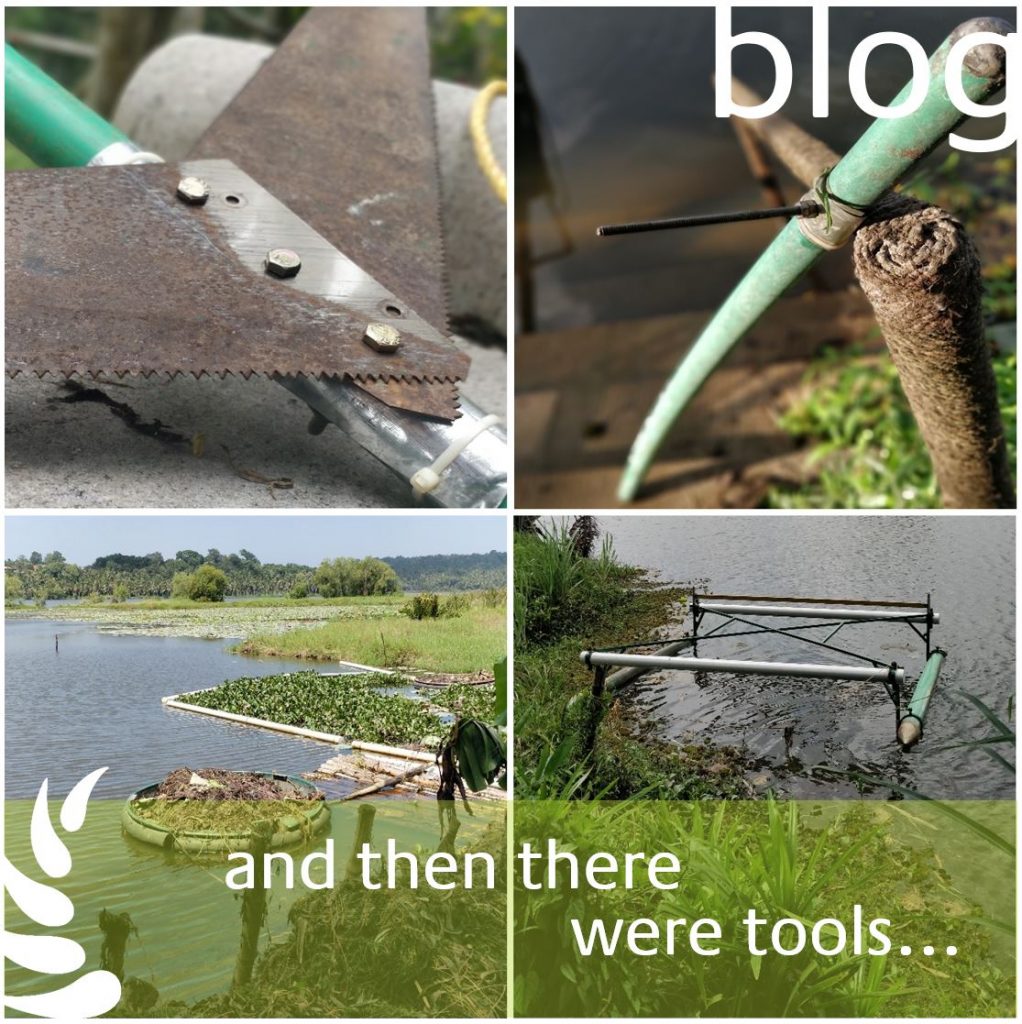And then there were tools…
By Chacko Jacob – kanthari catalyst
Around a million years ago, the Homo erectus discovered fire, changing the course of history. They gained control over something dangerous and powerful to their advantage. It helped them take on vast expanses previously unexplored, due to hostile conditions.
Up until recently, we have had very few tools at our disposal to rid Lake Vellayani of the invasive plants that threaten its existence. But since the last few months, there has been a fire growing in us. Call it ‘lockdown madness’ if you must, but we have caught the “tool fever”. We are practically obsessed with creating bigger and better tools to cut, split, uproot, and transport these weeds we so despise. Let us first have a look at the adversary, and then we shall learn about the ‘weapons’ specialized for them.
The common water hyacinth: a free-floating plant with bulbous stalks that can rise to 1m above, and dark fluffy roots that can extend up to 1m below the surface of the water. They grow extremely fast, near each other, forming “mats” on the surface, taking out sunlight, blocking heat to escape from the surface, and with the rising temperature of the water the oxygen level drops. Therefore, the wild and uncontrolled growth has disastrous consequences for all other plants and for the fish population. They can double in coverage area every two weeks, making them ruthlessly effective assassins of lakes, ponds and other water bodies around the globe.
The first tool, named the ‘Coronaberg’ (a play on its maker’s name), a simple walking stick with a curved handle started the tool fever that now inflicts us. The lengthy stick made it easy to reach for these plants, and the curve at the end could be used to get a better grasp. Once dragged into open waters, these loose plants could then be transported to the shore with the help of a net tied to 2x4s at both ends.
We soon grew greedy and wanted more than what a stick could free from the endless stretch of hyacinths. The net evolved into a chain of floating PVC pipes, with which we can “herd” large patches of hyacinth to the shore. But we soon ran into a new problem.
The lotus: there are large patches of only lotus in several parts of the lake, that also cause damage to the eco-system. Manual plucking of the roots has proven most effective, but when they grow along with the hyacinth, it becomes difficult to reach them. They also act as anchors for the otherwise free-floating hyacinths and this renders our herding tool useless.
So, the “whacker” was born. Weighing 4.5 Kilograms, and measuring 6 feet long, it was made of an old 1” pipe with two saw-blades bolted together on either side on one end. A long rope was attached to the other end. The whacker was thrown across a patch of hyacinths and, after it sank to the bottom, dragged along the bottom to cut through the anchoring lotus stems. It worked! We were soon bringing in chunks larger than the surface of the office rooms we work in. Yes, we do work, and we work hard, the lake and the tool making is during our playtime.
Not completely satisfied with this medieval contraption, we wanted bigger and better. As good as the whacker was, it required a lot of strength to operate. The spiny lotus stems were sometimes too strong for one person to handle. We thought of thin steel wires or a long band saw that two people could operate, and then Paul (the person who is behind these ideas), designed his ‘Frankenstein’s monster’, an approximately 4 by 3,5 metres float that drags a 3,5 metres long saw under the water. The ‘Frankenstein’ can easily go over patches of Hyacinth while cutting lotus stems underneath them.
And now, being again better equipped, we are bringing in massive loads, the size of football fields.
well, I mean the mini football field in front of our office building. With the further developments, we might get to regulation size football fields very soon! Another breakthrough is always around the corner. 🙂
Every day, after one to two hours of hacking and whacking, pulling and pushing with all our collective tools, the huge Hyacinth patch slowly gets smaller and smaller. We are re-claiming the lake; we shall not be defeated. And when all the strenuous physical activity is done, we do a quick swim or float, looking at the beautiful sunset and at the vegetal dent we created, anticipating a well-earned, tasty dinner.

